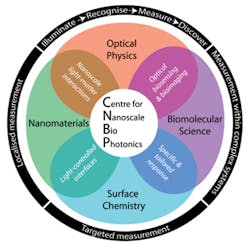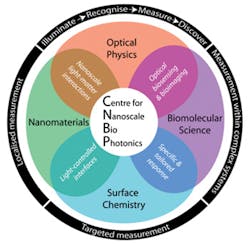BIOPHOTONICS RESEARCH/FUNDING: Biophotonics research attracts big investments
Recent announcements of biophotonics research investments in both of Earth's hemispheres bode well for life sciences.
A 'window into the body'
Federal funding of $23 million AUD (>$20 million USD) will let the University of Adelaide (Australia) establish a national Centre of Excellence for development of photonics-based technologies to study in vivo dynamics—alongside researchers from Macquarie University and the Royal Melbourne Institute of Technology (RMIT), and with key partners. The new Australian Research Council (ARC) Centre of Excellence for Nanoscale Biophotonics will bring together biology, lasers, and nanoscience using light-based sensors to probe molecular processes within living systems.
Center director Professor Tanya Monro said that, "Our understanding of the processes of life is limited by constraints imposed by studying cells and biological systems outside the body. Much more can be learnt if we can work within." She explained that the new center "...will use nanomaterials and photons to serve as an interface between organisms and artificially engineered systems. By bringing these fields together, we will transform our understanding of nanoscale events in living systems." She expects tangible outcomes in such areas as reproductive, immune system, and cardiovascular health. The Centre will address three themes that pose measurement questions not solved by existing technologies:
• The Spark of Life, by exploring approaches to sensing in and around developing embryos
• Origins of Sensation, by probing immune signals linked to touch and pain in the central nervous system
• Inside Blood Vessels, by exploring the role of the endothelium within blood vessels and the damaging effects of plaque.
Multidisciplinary biophotonics research
On the other side of the globe, a three-year, $10.8 million investment promises to boost multidisciplinary biophotonics research at Texas A&M University (College Station, TX), and to apply quantum laser technology developed at the Texas A&M Institute for Quantum Science and Engineering (IQSE). The funding will allow investment in cutting-edge laser-based technology and equipment and to recruit faculty, including Roy Glauber, a Harvard University (Cambridge, MA) professor who received the 2005 Nobel Prize in Physics, and Wolfgang Schleich, a University of Ulm (Germany) theoretical physicist—both of whom are 2013-14 Fellows with the Texas A&M Institute for Advanced Study (TIAS).
Biophotonics research goals for the award include specific projects that have far-reaching implications: 1. Increasing the speed and reliability of cancer diagnosis with high-sensitivity Raman signals; 2. Revolutionizing biological and chemical sensing with one-part-per-trillion sensitivity under normal atmospheric conditions, with implications for homeland security, agriculture, healthcare, and environmental sensing; 3. Spectroscopy-based detection of crop infection; and 4. Efficient, real-time anthrax detection with coherent anti-Stokes Raman spectroscopy (CARS).
Biomolecule imaging with x-ray lasers
Further north, the University at Buffalo (UB; Buffalo, NY), representing a national consortium of eight research universities and institutes, has received a $25 million Science and Technology Center grant from the National Science Foundation to "transform the field of structural biology, including drug development, using x-ray lasers." UB and its partners will establish the BioXFEL research center in Buffalo to develop new x-ray bioimaging techniques, including serial femtosecond crystallography, to analyze new molecular targets for drug discovery. "We will be able to analyze crystals 1,000 times smaller than the ones we can use now," says center director Eaton E. Lattman, Ph.D. "These are crystals we could never use before and, in fact, may not have known existed. A whole new universe of drug targets will become accessible for study as a result."

